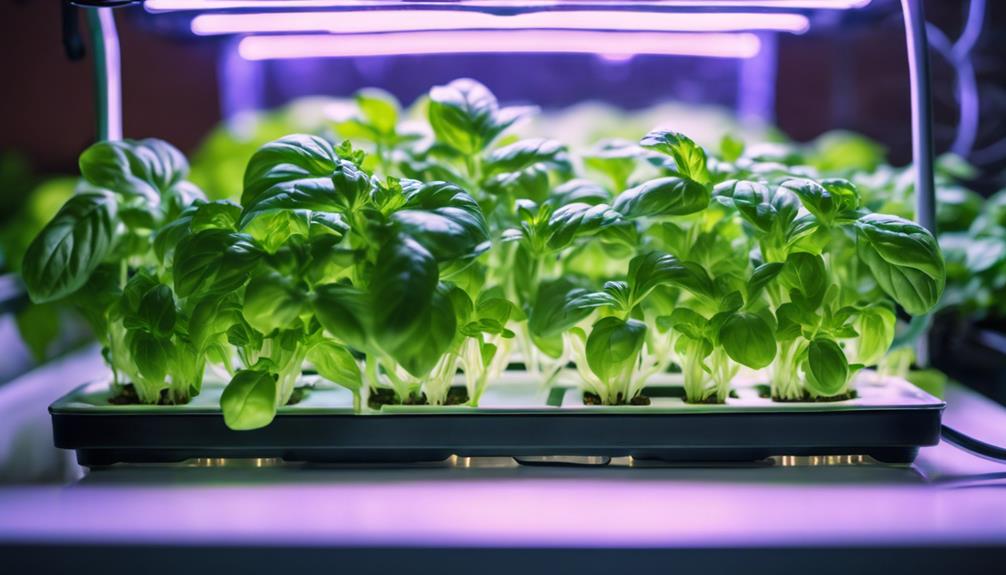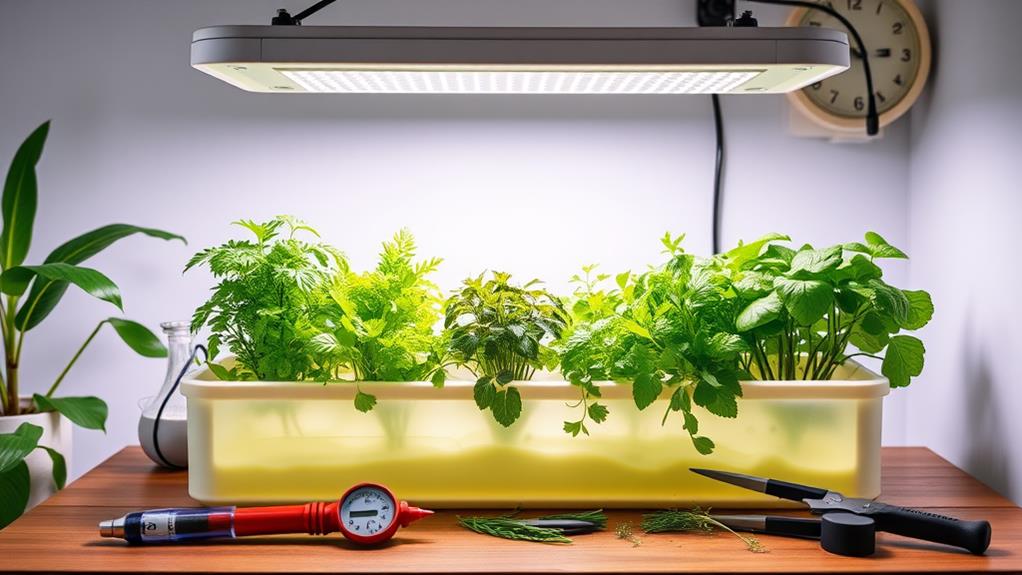What are the Essential Tips when Starting Herb Hydroponics?
Starting an herb hydroponics garden can be an exciting and rewarding experience, especially for those who love fresh, home-grown flavors. Dive into our essential tips to set up a thriving hydroponic herb garden, and soon you’ll be enjoying bountiful harvests right from your kitchen.
What do you need for starting herb hydroponics?
- Choose the right herbs—opt for low-maintenance varieties like basil and mint.
- Select a hydroponic system that suits your space; Deep Water Culture is great for beginners.
- Set up your garden with proper equipment, ensuring pH levels stay between 5.5 and 6.5.
- Monitor environmental conditions like temperature and humidity for ideal growth.
- Maintain nutrient levels regularly, adjusting as your plants grow.
- Implement proper lighting for 14-16 hours a day using full-spectrum LEDs.
- Develop a harvesting routine that encourages regrowth and flavor. You’ll find that exciting techniques await your exploration.
How to Choose the Right Herbs for Starting Herb Hydroponics?
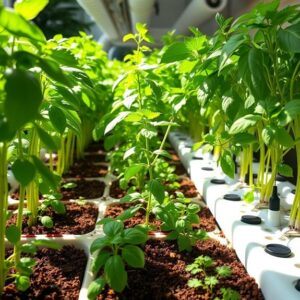
When starting your herb hydroponics journey, you’ll often find that choosing the right herbs is vital for success. Focus on culinary herbs known for their vigorous growth in hydroponic systems, like basil, cilantro, parsley, and mint. These herbs not only thrive but also bring zest and flavor to your meals.
For instance, basil is aromatic and versatile, making it ideal for various cuisines, while mint offers a revitalizing flavor that’s suitable for beverages and desserts. If you’re new to hydroponics, consider starting with low-maintenance options like chives and oregano. They adapt well to various setups, making them perfect for beginners.
Diversifying your garden is advantageous; mix culinary herbs with medicinal ones to enhance both flavor and health benefits. If you love teas, think about adding lemon balm or mint to your collection.
It’s important to choose herbs based on your preferences and how you plan to use them. Additionally, make certain you have proper growing media and nutrients available to support their growth.
Don’t forget to research the specific light and temperature requirements for each herb. This knowledge is critical for guaranteeing ideal growth in your hydroponic system.
How to Select the Right System when Starting Herb Hydroponics?
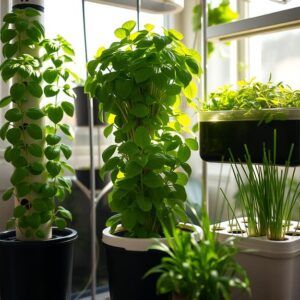
After selecting the right herbs for your hydroponic garden, the next step is to choose a hydroponic system that fits your space and growing aspirations.
Each system has its unique advantages and is suited for different herb types and growing environments. Here are some popular options:
- Deep Water Culture (DWC): Deep Water Culture is perfect for beginners, requiring just an air pump, reservoir, and nutrient solution. Roots grow directly in water.
- Nutrient Film Technique (NFT): NFT utilizes a thin film of nutrient-rich water flowing over roots, offering excellent oxygenation and nutrient uptake, ideal for fast-growing herbs.
- Ebb & Flow: Ebb & Flow periodically floods the growing area with nutrient solution, then drains it, ensuring efficient water and nutrient use while preventing root rot.
- Compact Systems: Great for small spaces, compact systems allow you to grow various herbs and gain experience before expanding.
- Water Levels Management: Maintaining ideal water levels is essential for healthy root systems and overall plant health.
Choosing the right hydroponic system can make all the difference in your herb-growing journey, so consider your options wisely!
How Do You Set Up Your Garden When Starting Herb Hydroponics?
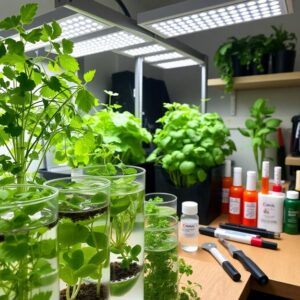
Setting up your hydroponic garden involves several key steps that will lay the foundation for successful herb cultivation.
First, choose a suitable hydroponic system, like Deep Water Culture (DWC) or Nutrient Film Technique (NFT), tailored to your space and herb growth needs. It’s also vital to understand the light requirements for the herbs you plan to grow, as this will greatly impact their growth and yield.
Next, use a plastic tote as a reservoir; make sure it’s opaque to prevent algae growth. Drill holes for net pots and air tubing to facilitate water and nutrient flow.
To guarantee ideal nutrient absorption, maintain a pH level between 5.5 and 6.5, testing the water regularly with a pH testing kit. Start with popular herbs like basil, cilantro, and parsley, planting 1-2 seeds in each pre-wetted rockwool cube positioned in your net pots.
Proper air circulation is vital, so confirm your indoor herb garden has adequate airflow and temperature control, ideally between 65-70°F. This will help support healthy growth and prevent mold and root rot.
Monitor Environmental Conditions
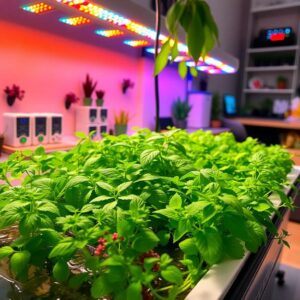
Monitoring environmental conditions is essential for successful herb hydroponics. By keeping a close eye on your garden’s surroundings, you can guarantee your plants thrive and produce bountiful harvests.
Here are key factors to monitor:
- Temperature: Maintain a stable range of 65-70°F (18-21°C) to promote ideal growth and prevent plant stress.
- Light Exposure: Confirm your plants receive 14-16 hours of light each day. If natural sunlight falls short, invest in quality grow lights, particularly LED grow lights that are energy-efficient and provide a balanced spectrum for ideal growth.
- Humidity: Aim for humidity levels between 40-70%. This prevents mold growth while keeping your plants healthy.
- pH Level: Regularly check and adjust the pH level of your nutrient solution, keeping it between 5.5-6.5 for ideal nutrient absorption.
- Air Circulation: Use fans or a ventilation system to enhance air circulation, which helps prevent fungal diseases and strengthens your plants.
Maintain Nutrient Levels
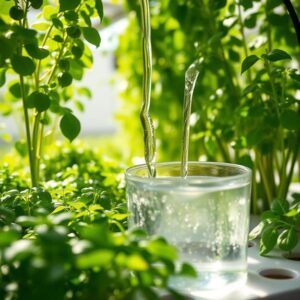
Maintaining proper nutrient levels is crucial for the health and growth of your hydroponic herbs. To guarantee your plants thrive, regularly check and maintain the nutrient water levels. You don’t want the water to drop critically low, as this can stress your herbs. Aim for a total dissolved solids (TDS) level around 1,300 ppm to create ideal nutrient conditions.
Adjust your nutrient amounts based on the growth stage of your plants, following General Hydroponics guidelines for precise measurements. It’s also important to use spring water for mixing your nutrients, as it helps facilitate easier pH adjustments. Endeavor to keep the pH level around 6 for ideal nutrient absorption.
Additionally, replace the nutrient water every 2-3 weeks while reassessing the pH and TDS levels each time. This regular maintenance will guarantee the health and liveliness of your hydroponic herbs.
How Do You Implement Proper Lighting When Starting Herb Hydroponics?
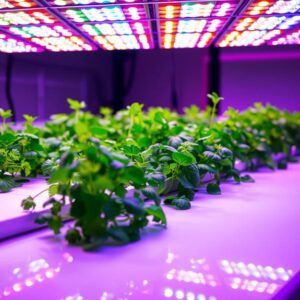
After confirming your nutrient levels are ideal, the next key element in nurturing your hydroponic herbs is proper lighting.
To promote vigorous growth and healthy photosynthesis, you need a light cycle of 14-16 hours per day. Full-spectrum LED grow lights are your best bet; they provide the necessary wavelengths for plant development while being energy-efficient and producing less heat than traditional bulbs.
Here are some essential tips for implementing proper lighting:
- Position your grow lights 12-24 inches above the plants to optimize light intensity.
- Regularly monitor light exposure to confirm all herbs receive even lighting.
- Use a timer to maintain a consistent light schedule, reducing stress on your plants.
- Adjust the height of the lights as your plants grow to prevent leaf burn.
- Aim to prevent leggy growth, encouraging bushier plants that thrive.
Harvest and Enjoy Your Herbs
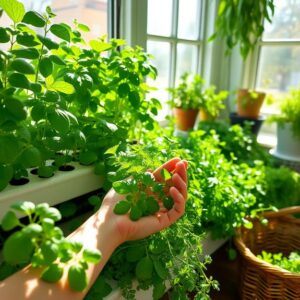
To get the most out of your hydroponic herbs, timing your harvest is essential; aim to cut leaves above a node to encourage regrowth and prevent flavor loss.
After harvesting, use clean, sharp scissors to minimize plant damage and maintain freshness.
Store your herbs properly to enjoy their vibrant flavors in your favorite dishes, ensuring you maximize their nutritional benefits.
Optimal Harvest Timing
Timing your herb harvest can considerably enhance the flavor and aroma of your culinary creations. To achieve ideal results, keep an eye on your herbs as they grow. Aim to harvest them when they reach a height of 6-8 inches and display a healthy number of leaves.
For most herbs, the peak time to harvest is just before flowering, when their essential oils are most concentrated.
Here are some essential tips for timely harvesting:
- Harvest in the morning after the dew has dried for the best flavor and aroma.
- Pinch off the top leaves regularly to promote bushier growth and prevent leggy plants.
- Use clean, sharp scissors or pruners to make clean cuts, reducing stress on your plants.
- Consider the individual growth cycle of each herb, as some may need more frequent harvesting than others.
- Monitor the aroma; if it’s particularly strong, it’s likely time to harvest!
Preserving Freshness Methods
Preserving the freshness of your herbs right after harvest is essential for maximizing their flavor and aroma in your dishes. You should harvest herbs in the early morning when they’re most fragrant and still have high moisture content. Use clean, sharp pruning shears to snip stems just above a leaf node, promoting healthy regrowth while preventing damage to your plants.
To store freshly harvested herbs, follow these methods:
| Method | Details |
|---|---|
| Refrigerate | Place herbs in a jar of water, covered loosely with a plastic bag, to maintain moisture for up to a week. |
| Freezing Herbs | Freeze herbs in ice cube trays filled with water or oil for long-term storage, preserving flavor and nutrients. |
| Drying | Hang herbs upside down in a cool, dark place with good air circulation to maintain their aroma and potency. |
| Pruning | Regularly prune herbs to encourage healthy regrowth and guarantee a continuous supply for your culinary needs. |
Follow these Tips When Starting Herb Hydroponics!
By following these seven essential tips, you’ll cultivate a thriving herb hydroponics garden that bursts with flavor and freshness. Picture your kitchen adorned with vibrant green basil, fragrant mint, and zesty cilantro, ready to elevate every dish. With the right setup and care, you’ll not only enjoy a bountiful harvest but also the satisfaction of growing your own herbs. So roll up your sleeves, plunge into, and watch your hydroponic dreams take root!
Questions? We Have Answers.
Get answers to a list of the most Frequently Asked Questions.

